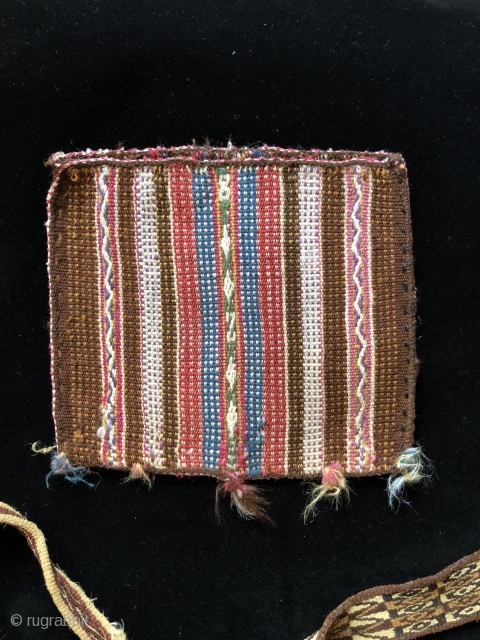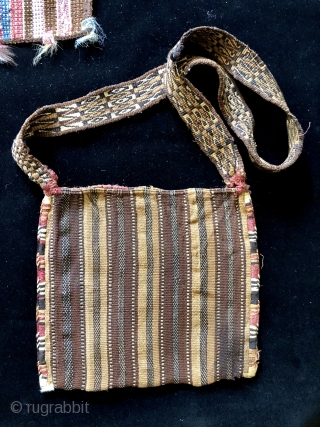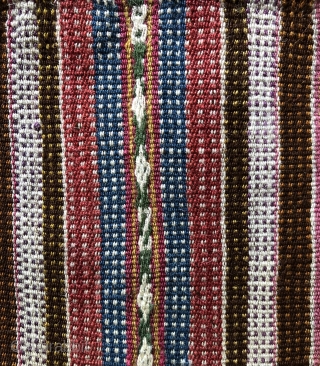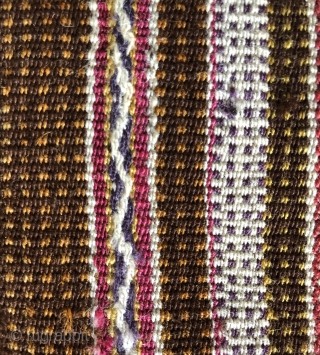Archeological evidence confirms that coca bags have had an important place in the weaving repertoire of the Aymara since at least a.d. 300 and before. Pre-Columbian examples survive that are a direct link to 19th century Aymara bags. Coca was considered the most sacred plant in the Andes and was essential to the ritual and ceremonial life of the Aymara as well as being part of nearly every social interaction. Coca was shared upon meeting others. One’s coca bag was a source of pride in these situations. Coca was chewed with a substance usually derived from the ash of the quinoa plant – a staple grain of the region. This lime-like substance acted as a catalyst releasing the alkaloids in the coca leaves when inserted onto a quid of partially masticated leaves. When chewed, coca leaf acts as a mild stimulant and helps suppress hunger, thirst, pain, and fatigue. This is why it was so important to the Aymara people who lived at high altitude. Woven bags that were made to hold coca leaves were called chuspas. Lavish attention and the use of the finest materials were part of the tradition of the weaving of these bags. Even though they are relatively small textiles, they had an inordinate importance within the culture which helps to explain the remarkably beautiful spinning, dyeing and weaving that went into creating 19th century coca bags.
Of the three bags pictured here only the colorful bag is a 19th century Aymara bag. It features three complimentary warp woven design bands with designs that hark back to ancient times. It also features brilliantly colored areas of alternating colored warps that create a “zipper-like” ground weave - a technique that is shared by the two Pre-Columbian bags also seen here. Like most Aymara bags it has a woven tubular edge finish. The other two bags were woven during the Inca period of Andean history or before. The finer of the two bags with the wide strap is classic Inca. It shows the type of edge finish known as a cross knit loop stitch and was done in red, yellow, black and white. This type of edge finish is a defining characteristic of Incan textiles. There are no dyes in the body of this bag. The alpaca hair used here is in natural shades of alpaca. The strap is a complimentary warp woven band. The other bag also has no dyes used in the body of the bag - only natural colored alpaca fiber. It has a different type of edge finish that is a three color warp faced, tublar weave with the wefts actually attaching it to the bags edges – a feature also seen in 19th century Aymara bags. Alpacas are members of the Camelidae family – American Camels so to speak - and come in a remarkable number of colors. White alpacas were considered the most valuable because white fiber could be dyed to show off the wide array of natural dyes found in Aymara textiles. Alpaca fiber is among the finest animal fiber in the world. It is a long staple hair with very long individual fibers and a surface that has fewer microscopic scales than that of sheep wool. This long staple feature allows for extremely fine yarns to be spun from Alpaca fiber and the lack of scales accounts for the brilliant sheen of the yarns. The spinning in the Andean region is finer than anywhere else in the world. Yarns are always two ply in Aymara weavings. The colorful Aymara bag seen here was posted recently on my rugrabbit pages and has since sold. See this link for reference.
http://www.rugrabbit.com/node/214544
More to follow in future posts.
- Home
- Antique Rugs by Region
- Category
- Profiles
- Post Items Free
- Albums
- Benaki Museum of Islamic Art
- Budapest: Ottoman Carpets
- Gulbenkian Museum
- Islamic Carpets. Brooklyn
- Islamic Textiles. Brooklyn
- Konya Museum: Rugs
- MKG, Hamburg
- MMA: Caucasian Carpets
- MMA: Mamluk Carpets
- MMA: Mughal Indian Carpets
- MMA: Ottoman Carpets
- MMA: Safavid Persian Carpets
- MMA: Turkmen Rugs
- McCoy Jones Kilims
- Ottoman textiles. Met
- Philadelphia Museum
- Rugs and Carpets: Berlin
- Seljuqs at the Met
- TIEM, Istanbul: Carpets
- V&A: Classical Carpets
- Vakiflar Carpets: Istanbul
- Baluch Rugs: Indianapolis
- Gallery Exhibitions
- Jaf an Exhibition
- Alberto Levi Gallery
- Andean Textile
- Christie's London: 2016
- Francesca Galloway
- HALI at 40
- ICOC Washington, DC 2018
- Jajims of the Shahsavan
- London Islamic Week April, 2018
- Mongolian Felts
- Navajo Rugs: JB Moore
- Persian Piled Weavings
- SF Tribal & Textile Art Show 2020
- SF Tribal 2019
- Sotheby's: C. Alexander
- Turkish Prayer Rugs
- Turkmen Main Carpets ICOC 2007















